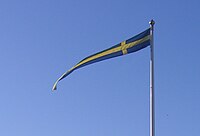Household pennant
You can help expand this article with text translated from the corresponding article in Finnish. (February 2023) Click [show] for important translation instructions.
|

Household pennant is a quite common Nordic and Scandinavian tradition. A household pennant (Finnish: isännänviiri; Swedish: vimpel; Norwegian: vimpel; Danish: vimpel) can be flown whenever there is no flag flying day and it is usually a means of telling that the "master of the house" is at home or simply for decorations. Due to this, pennants flags are usually a more common sight than the national flag in these countries. These pennants have a long, narrow, triangular shape, usually half the length of the flag pole. The pennants are also used in some countries for determining the wind direction. Unlike the national flag, which usually has a specific timeframe it can formally be flown during the day, pennants are regarded as more informal, and can be flown all day and night until worn out.
Denmark[edit]

Danish pennants retain the cross of the Dannebrog and are generally very long and thin. The pennants can be connected to the pole like a traditional flag, or via a single lanyard, giving the pennant the ability to rotate while flying.
-
Denmark
Finland[edit]

Finnish pennants retain the cross design of their national flag. The pennants triangle has a base of roughly one tenth of the length and it is connected to the pole via a single lanyard, giving the pennant the ability to rotate while flying.[1] The shapes, designs and uses of the pennants are however not regulated by law, as long as they do not interfere with uses of the regular flag, which is regulated. It is also allowed to fly a pennant overnight. In addition to the general pennant (which is based on the flag of Finland) and the regional variants, there are also family, city and municipality variants, of which any may be flown. A common practice is to either fly the pennant of the region of residence or the pennant from which the family members come.
-
Finland
Finnish regional pennants[edit]
The different regions of Finland have been connected with some traditional colors (often from the coats of arms of the historical provinces of Finland and modern provinces), and these are often reflected in the household pennant. The pennants sometimes also incorporate the regional arm into the design. A common practice is to either fly the pennant of the region of residence or the pennant from which the family members come. As the household pennant is connected to the pole with a single lanyard, the pennant has the ability to revolve around its horizontal axis. Thus, an actual pennant does not have a "top" side, making some of the pennants identical in practice.
-
Pennant of Åland
-
Pennant of Central Finland
-
Pennant of Central Ostrobothnia
-
Pennant of Kainuu
-
Pennant of Karelia
-
Pennant of Kymenlaakso
-
Pennant of Lapland
-
Pennant of Northern Ostrobothnia
-
Pennant of Satakunta
-
Pennant of Savonia
-
Pennant of South Karelia
-
Pennant of Southern Ostrobothnia
-
Pennant of Southwest Finland
-
Pennant of Swedish-speaking Ostrobothnia
-
Pennant of Tavastia
-
Pennant of Uusimaa
The colors of the coat of arms[edit]
-
Pennant of South Karelia
-
Pennant of Kymenlaakso
-
Pennant of Pirkanmaa
-
Pennant of Ostrobothnia
-
Pennant of North Karelia
-
Pennant of Päijät-Häme
-
Pennant of Päijät-Häme (1983-1997)
-
Pennant of Southwest Finland
Norway[edit]

Norwegian pennants do not contain the nordic cross and instead uses a single stripe in blue with white borders on a red triangular canvas. Although they may sometimes appear different such as with the nordic cross motif of the national flag, but these alternative designs are very uncommon compared to the single stripe design. Municipal specific pennants are also sometimes used by certain national subdivisions as decorations. When pennants of other Nordic countries are flown in Norway alongside the Norwegian pennant, the design of the single stripe is carried over to the other Nordic pennants.
-
Norwegian Pennant
-
Oslo Pennant
Sweden[edit]

The design of Swedish pennants, unlike other Nordic pennants, are regulated. These pennants must be half blue and half yellow, with blue on top. Swedish pennants with cross designs are not approved, considered historically inaccurate and is therefore advised to not be used. The length of the pennant should be 1/3 of the flagpole. The colors are not defined, but should match those of the national flag.[2]

-
Sweden
-
Sweden (with cross)
-
Scania (with cross)
Other[edit]

-
Sámi Pennant
-
Kven Pennant
-
Forest Finn Pennant
See also[edit]
References[edit]
- ^ Finnish "husband" pennants Flags of the World
- ^ Riksarkivet. "Vimpel". riksarkivet.se (in Swedish).
External links[edit]
- Isännänviirit Flagmore (in Finnish)






